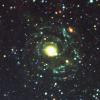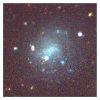
Barely visible galaxies are the key to understanding the Universe
11-06-2024
When we look at the night sky, we cannot free ourselves from questions. We wonder if it is possible to count the stars. We imagine how great a distance separates us from them. When we realize what a light year actually is, we are surprised to discover that we are actually looking into the further or closer past. Scientists from the National Centre for Nuclear Research experience a similar fascination, looking for answers to these and other questions about how the Universe looks and works. In the coming years, this search will be able to be more effective thanks to the project „ Barely visible: low surface brightness galaxies in the LSST era” under the supervision of Prof. dr hab. Agnieszka Pollo financed by the National Science Center under the MAESTRO program.
All existing surveys of astronomical objects have limitations, due to the accuracy of the instruments and, in the case of ground-based observations, also to the fact that the Earth’s atmosphere interferes with our observations. Consequently, our knowledge of the Universe is mainly based on observations of relatively bright objects.
Meanwhile, we have known since the 1980s that there are galaxies in the Universe that very easily escape observation. These are so-called low surface brightness galaxies, or more precisely, galaxies with a brightness lower than the typical brightness of the night sky. The first such galaxy was discovered by astronomer David Malin in 1986 – it is called Malin 1 and remains one of the largest known spiral galaxies to this day. Most of the currently known galaxies of this type are much smaller dwarf galaxies, but the variety of types among these galaxies is similar to that of their bright cousins.
The number of known low surface brightness galaxies has been increasing over the years. Initially, they were discovered mainly by chance, on the occasion of deep observations of selected areas of the sky. A systematic search for these objects has only recently begun. It turned out that they are virtually everywhere. Also, bright galaxies are surrounded by a faint glow, which sometimes extends over enormous distances.
There are still more questions about these objects than answers. How many are there? How much ’normal’ baryonic matter is in them, and can they help explain the so-called ’missing baryons’ puzzle – the fact that we observe less baryonic matter in the Universe today than in earlier cosmological epochs? Can they explain another cosmological problem – the so-called problem of missing satellites, i.e. the fact that we observe fewer small galaxies than predicted by theoretical models? What processes led to their formation, and why are they different from ’normal’ galaxies? When did such galaxies form, and what did they look like in the past?
The atmosphere has been heated by studies of so-called ultra diffuse galaxies, a particular subtype of low surface brightness galaxies found in galaxy clusters. Among these, galaxies have been found that consist almost entirely – 99% – of dark matter, as well as galaxies that appear to be completely devoid of dark matter. How is this possible and what processes lead to such extreme objects? Can their existence be explained on the basis of the currently accepted cosmological model? Or do we need to change the laws of physics for them?
Answering these questions requires observing large areas of the sky with large telescopes capable of observing the faint glow of low surface brightness galaxies. A revolution in sky observation will be brought about by the Vera Rubin Observatory, whose construction in Chile is just finishing and whose main objective is to create the Legacy Survey of Space and Time (LSST). The 8.4-metre telescope installed there, equipped with the world’s largest wide-angle camera, will start scouring the entire southern sky in two years’ time.
„The aim of the proposed project is to build a team that, using simulations and currently available data, will develop new and improved methods to search for and classify low surface brightness galaxies” – prof. Pollo explains. „We want to improve and develop new methods to study their physical properties, and finally, after applying the developed methods to the LSST data, try to answer questions about the role of low surface brightness galaxies in the evolution of the Universe – and the relevance to the laws of physics that govern it.
Congratulations on funding the project and we look forward to fascinating new observations.






